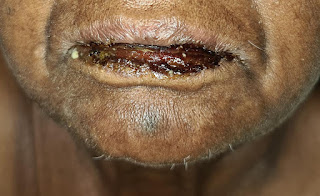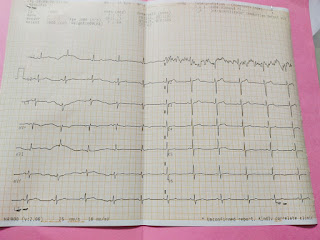A 35 year male patient with shortness of breath and pedal edema
G sai tejaswini
Roll no :61
I have been given this case to solve in an attempt to understand the topic of patient clinical data analysis to develop my competency in reading and comprehending clinical data including history , clinical findings, investigations, come up with a diagnosis treatment plan.
The entire real patient clincal data in this linkhttps://madhur116.blogspot.com/2020/05/on-1452020.html?m=1
COMPLAINTS:
* fever -1month back
*shortness of breath- since 2weeks
*pedal edema-since 2 weeks
FEVER: 1month back which was high grade associated with chills
Probable causes may be -
1. Viral infections
2. Meningitis(no features suggestive)
3. Typhoid(no features suggestive).
4. Malaria.
Treatment given anti malarials by local rmp.
SHORTNESS OF BREATH:since 2weeks
Initialy it was NYHA grade 3 but after treatment it became NYHA grade 2,
History of paroxysmal nocturnal dyspnea
Probable causes may be :
Cardiac causes
Pulmonary causes ( no history of cough , cold, wheeze , so it is ruled out)
Renal causes (no feature of oliguria , facial puffiness it is also ruled out)
PEDAL EDEMA: since 2 weeks bilateral progressive in nature extended upto knee.
Probable causes may be
Cardiac causes
Renal causes( no features suggestive)
Liver causes
EXAMINATION, INVESTIGATIONS:
edema upto knees (grade 2)
Rs:right ISA early inspiratory crepitus is present
https://drive.google.com/file/d/1Gr2xuU5bcPUbNmQaPjVlavwn1mFK7gr/view?usp=drivesdk
2D echo findings:
ejection fraction is 27 %
ivc dilated but not collapsed
mild TR+,severeMR+, trival AR+
all chambers are dilated.
global hypokinesia, sevre lv dysfunction
mild pulmonary artery hypertension
no MS, AS, PE/LV clot.
USG findings: right moderate pleural effusion grade 1 fatty liver, mild ascites
https://journal.chestnet.org/article/S0012-3692(16)32070-0/fulltext
By above features iam thinking they are cardiac related features.
ANALYSIS: diagnosis may be heart failure.
Here patient shows left , right sided heart failure features.
So it may congestive cardiac failure.
ANATOMICAL SITE: heart
PHYSIOLOGIAL DISABILITY: shortness of breath , pedal edema
PATHOLOGY: here left ventricular failure
has lead to increase in backward pressure in left atrium which lead to increase pressure pulmonary veins and lead to lung dysfunction finaly leading to right heart failure causing pedal edema.
Whether the heart failure is systolic heart failure or diastolic heart failure ?
By the feature of 2D echo ( ejection fraction is 27%) , it is heart failure with reduced ejection fraction.
Here there is problem in pumping blood , left ventricular hypertrophy is present.
By this it is heart failure with reduced ejection fraction.
Causes for HFrEF:
myocardial infarction ( no history of chest pain, syncope, palpitations it is ruled out).
Dilated cardiomyopathy
CAUSE: due to dialated cardiomyopathy(2D echo findings- chambers are dialated).
Aortic , mitral regurgitation(2D echo findings).
Etiology for dialated cardiomyopathy ?
It may due to infections, alcohol induced.
Patient has history of fever so it may due to infections leading to myocarditis.
Mostly there may be viral etiology leading to this disease.
DIAGNOSIS : heart failure with reduced ejection fraction secondary to viral myocarditis.
TREATMENT:
PHARMACOLOGICALLY:
REFERENCES:
https://madhur116.blogspot.com/2020/05/on-1452020.html?m=1
https://journal.chestnet.org/article/S0012-3692(16)32070-0/fulltext
Davidson text book https://www.baptisthealth.com/services/heart-care/conditions/left-sided-heart-failure
Roll no :61
I have been given this case to solve in an attempt to understand the topic of patient clinical data analysis to develop my competency in reading and comprehending clinical data including history , clinical findings, investigations, come up with a diagnosis treatment plan.
The entire real patient clincal data in this linkhttps://madhur116.blogspot.com/2020/05/on-1452020.html?m=1
COMPLAINTS:
* fever -1month back
*shortness of breath- since 2weeks
*pedal edema-since 2 weeks
FEVER: 1month back which was high grade associated with chills
Probable causes may be -
1. Viral infections
2. Meningitis(no features suggestive)
3. Typhoid(no features suggestive).
4. Malaria.
Treatment given anti malarials by local rmp.
SHORTNESS OF BREATH:since 2weeks
Initialy it was NYHA grade 3 but after treatment it became NYHA grade 2,
History of paroxysmal nocturnal dyspnea
Probable causes may be :
Cardiac causes
Pulmonary causes ( no history of cough , cold, wheeze , so it is ruled out)
Renal causes (no feature of oliguria , facial puffiness it is also ruled out)
PEDAL EDEMA: since 2 weeks bilateral progressive in nature extended upto knee.
Probable causes may be
Cardiac causes
Renal causes( no features suggestive)
Liver causes
EXAMINATION, INVESTIGATIONS:
edema upto knees (grade 2)
Rs:right ISA early inspiratory crepitus is present
JVP : was found to raised
https://drive.google.com/file/d/1Gr2xuU5bcPUbNmQaPjVlavwn1mFK7gr/view?usp=drivesdk
2D echo findings:
ejection fraction is 27 %
ivc dilated but not collapsed
mild TR+,severeMR+, trival AR+
all chambers are dilated.
global hypokinesia, sevre lv dysfunction
mild pulmonary artery hypertension
no MS, AS, PE/LV clot.
USG findings: right moderate pleural effusion grade 1 fatty liver, mild ascites
https://journal.chestnet.org/article/S0012-3692(16)32070-0/fulltext
By above features iam thinking they are cardiac related features.
ANALYSIS: diagnosis may be heart failure.
So it may congestive cardiac failure.
ANATOMICAL SITE: heart
PHYSIOLOGIAL DISABILITY: shortness of breath , pedal edema
PATHOLOGY: here left ventricular failure
has lead to increase in backward pressure in left atrium which lead to increase pressure pulmonary veins and lead to lung dysfunction finaly leading to right heart failure causing pedal edema.
Whether the heart failure is systolic heart failure or diastolic heart failure ?
By the feature of 2D echo ( ejection fraction is 27%) , it is heart failure with reduced ejection fraction.
Here there is problem in pumping blood , left ventricular hypertrophy is present.
By this it is heart failure with reduced ejection fraction.
Causes for HFrEF:
myocardial infarction ( no history of chest pain, syncope, palpitations it is ruled out).
Dilated cardiomyopathy
CAUSE: due to dialated cardiomyopathy(2D echo findings- chambers are dialated).
Aortic , mitral regurgitation(2D echo findings).
Etiology for dialated cardiomyopathy ?
It may due to infections, alcohol induced.
Patient has history of fever so it may due to infections leading to myocarditis.
Mostly there may be viral etiology leading to this disease.
DIAGNOSIS : heart failure with reduced ejection fraction secondary to viral myocarditis.
TREATMENT:
PHARMACOLOGICALLY:
Tab.lasix 80mg...40mg...40mg
Tab.isosorbide mononitrate10mg bd
Tab.hydralazine 25mg
Tab. Telma20mg
Tab.metformin 500mg po od
NON PHARMACOLOGICALLY:
Reduce physical stress.
Restrict fluid , salt intake
https://madhur116.blogspot.com/2020/05/on-1452020.html?m=1
https://journal.chestnet.org/article/S0012-3692(16)32070-0/fulltext
Davidson text book https://www.baptisthealth.com/services/heart-care/conditions/left-sided-heart-failure






Comments
Post a Comment